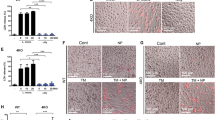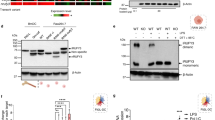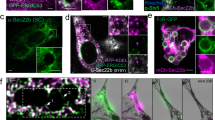Abstract
Phagocytosis is a pivotal process by which macrophages eliminate microorganisms after recognition by pathogen sensors. Here we unexpectedly found that the self ligand and cell surface receptor SLAM functioned not only as a costimulatory molecule but also as a microbial sensor that controlled the killing of Gram-negative bacteria by macrophages. SLAM regulated activity of the NADPH oxidase NOX2 complex and phagolysosomal maturation after entering the phagosome, following interaction with the bacterial outer membrane proteins OmpC and OmpF. SLAM recruited a complex containing the intracellular class III phosphatidylinositol kinase Vps34, its regulatory protein kinase Vps15 and the autophagy-associated molecule beclin-1 to the phagosome, which was responsible for inducing the accumulation of phosphatidylinositol-3-phosphate, a regulator of both NOX2 function and phagosomal or endosomal fusion. Thus, SLAM connects the Gram-negative bacterial phagosome to ubiquitous cellular machinery responsible for the control of bacterial killing.
This is a preview of subscription content, access via your institution
Access options
Subscribe to this journal
Receive 12 print issues and online access
$209.00 per year
only $17.42 per issue
Buy this article
- Purchase on Springer Link
- Instant access to full article PDF
Prices may be subject to local taxes which are calculated during checkout








Similar content being viewed by others
References
Stuart, L.M. & Ezekowitz, R.A. Phagocytosis and comparative innate immunity: learning on the fly. Nat. Rev. Immunol. 8, 131–141 (2008).
Aderem, A. & Ulevitch, R.J. Toll-like receptors in the induction of the innate immune response. Nature 406, 782–787 (2000).
Calpe, S. et al. The SLAM and SAP gene families control innate and adaptive immune responses. Adv. Immunol. 97, 177–250 (2008).
Rethi, B. et al. SLAM/SLAM interactions inhibit CD40-induced production of inflammatory cytokines in monocyte-derived dendritic cells. Blood 107, 2821–2829 (2006).
Tatsuo, H., Ono, N., Tanaka, K. & Yanagi, Y. SLAM (CDw150) is a cellular receptor for measles virus. Nature 406, 893–897 (2000).
Malaviya, R., Gao, Z., Thankavel, K., van der Merwe, P.A. & Abraham, S.N. The mast cell tumor necrosis factor alpha response to FimH-expressing Escherichia coli is mediated by the glycosylphosphatidylinositol-anchored molecule CD48. Proc. Natl. Acad. Sci. USA 96, 8110–8115 (1999).
Wang, N. et al. The cell surface receptor SLAM controls T cell and macrophage functions. J. Exp. Med. 199, 1255–1264 (2004).
Backer, J.M. The regulation and function of class III PI3Ks: novel roles for Vps34. Biochem. J. 410, 1–17 (2008).
Laroux, F.S., Romero, X., Wetzler, L., Engel, P. & Terhorst, C. Cutting edge: MyD88 controls phagocyte NADPH oxidase function and killing of gram-negative bacteria. J. Immunol. 175, 5596–5600 (2005).
Lambeth, J.D. NOX enzymes and the biology of reactive oxygen. Nat. Rev. Immunol. 4, 181–189 (2004).
Segal, A.W. How neutrophils kill microbes. Annu. Rev. Immunol. 23, 197–223 (2005).
Savina, A. et al. NOX2 controls phagosomal pH to regulate antigen processing during crosspresentation by dendritic cells. Cell 126, 205–218 (2006).
Miksa, M., Komura, H., Wu, R., Shah, K.G. & Wang, P. A novel method to determine the engulfment of apoptotic cells by macrophages using pHrodo succinimidyl ester. J. Immunol. Methods 342, 71–77 (2009).
Blander, J.M. & Medzhitov, R. On regulation of phagosome maturation and antigen presentation. Nat. Immunol. 7, 1029–1035 (2006).
Trivedi, V., Zhang, S.C., Stockinger, W. & Nohturfft, A.A. Cell-free scintillation proximity assay for studies on lysosome-to-phagosome targeting. Sci. STKE 2007, l3 (2007).
Boes, M. et al. T-cell engagement of dendritic cells rapidly rearranges MHC class II transport. Nature 418, 983–988 (2002).
Kitano, M., Nakaya, M., Nakamura, T., Nagata, S. & Matsuda, M. Imaging of Rab5 activity identifies essential regulators for phagosome maturation. Nature 453, 241–245 (2008).
Rohde, K., Yates, R.M., Purdy, G.E. & Russell, D.G. Mycobacterium tuberculosis and the environment within the phagosome. Immunol. Rev. 219, 37–54 (2007).
Howie, D. et al. Molecular dissection of the signaling and costimulatory functions of CD150 (SLAM): CD150/SAP binding and CD150-mediated costimulation. Blood 99, 957–965 (2002).
Yates, R.M. & Russell, D.G. Phagosome maturation proceeds independently of stimulation of toll-like receptors 2 and 4. Immunity 23, 409–417 (2005).
Basle, A., Rummel, G., Storici, P., Rosenbusch, J.P. & Schirmer, T. Crystal structure of osmoporin OmpC from E. coli at 2.0 A. J. Mol. Biol. 362, 933–942 (2006).
Yeung, T., Ozdamar, B., Paroutis, P. & Grinstein, S. Lipid metabolism and dynamics during phagocytosis. Curr. Opin. Cell Biol. 18, 429–437 (2006).
Vieira, O.V. et al. Distinct roles of class I and class III phosphatidylinositol 3-kinases in phagosome formation and maturation. J. Cell Biol. 155, 19–26 (2001).
Bissonnette, S.A. et al. Phosphatidylinositol 3-phosphate-dependent and -independent functions of p40phox in activation of the neutrophil NADPH oxidase. J. Biol. Chem. 283, 2108–2119 (2008).
Lawe, D.C. et al. Sequential roles for phosphatidylinositol 3-phosphate and Rab5 in tethering and fusion of early endosomes via their interaction with EEA1. J. Biol. Chem. 277, 8611–8617 (2002).
Psachoulia, E. & Sansom, M.S.P. PX- and FYVE-mediated interactions with membranes: simulation studies. Biochemistry 48, 5090–5095 (2009).
Yan, Y. & Backer, J.M. Regulation of class III (Vps34) PI3Ks. Biochem. Soc. Trans. 35, 239–241 (2007).
Kinchen, J.M. et al. A pathway for phagosome maturation during engulfment of apoptotic cells. Nat. Cell Biol. 10, 556–566 (2008).
Juhasz, G. et al. The class III PI(3)K Vps34 promotes autophagy and endocytosis but not TOR signaling in Drosophila. J. Cell Biol. 181, 655–666 (2008).
Lindmo, K. et al. The PI 3-kinase regulator Vps15 is required for autophagic clearance of protein aggregates. Autophagy 4, 500–506 (2008).
Matsunaga, K. et al. Two Beclin 1-binding proteins, Atg14L and Rubicon, reciprocally regulate autophagy at different stages. Nat. Cell Biol. 11, 385–396 (2009).
Zhong, Y. et al. Distinct regulation of autophagic activity by Atg14L and Rubicon associated with Beclin 1-phosphatidylinositol-3-kinase complex. Nat. Cell Biol. 11, 468–476 (2009).
Basle, A., Rummel, G., Storici, P., Rosenbusch, J.P. & Schirmer, T. Crystal structure of osmoporin OmpC from E. coli at 2.0 A. J. Mol. Biol. 362, 933–942 (2006).
Yoshida, T., Qin, L., Egger, L.A. & Inouye, M. Transcription regulation of ompF and ompC by a single transcription factor, OmpR. J. Biol. Chem. 281, 17114–17123 (2006).
Landers, C.J. et al. Selected loss of tolerance evidenced by Crohn's disease-associated immune responses to auto- and microbial antigens. Gastroenterology 123, 689–699 (2002).
Glick, D., Barth, S. & Macleod, K.F. Autophagy: cellular and molecular mechanisms. J. Pathol. 221, 3–12 (2010).
Virgin, H.W. & Levine, B. Autophagy genes in immunity. Nat. Immunol. 10, 461–470 (2009).
Desjardins, M., Nzala, N.N., Corsini, R. & Rondeau, C. Maturation of phagosomes is accompanied by changes in their fusion properties and size-selective acquisition of solute materials from endosomes. J. Cell Sci. 110, 2303–2314 (1997).
Sanjuan, M.A. et al. Toll-like receptor signalling in macrophages links the autophagy pathway to phagocytosis. Nature 450, 1253–1257 (2007).
Huang, J. et al. Activation of antibacterial autophagy by NADPH oxidases. Proc. Natl. Acad. Sci. USA 106, 6226–6231 (2009).
Beutler, B. Microbe sensing, positive feedback loops, and the pathogenesis of inflammatory diseases. Annu. Rev. Immunol. 227, 248–263 (2009).
Stockinger, W. et al. Differential requirements for actin polymerization, calmodulin, and Ca2+ define distinct stages of lysosome/phagosome targeting. Mol. Biol. Cell. 17, E05–E12 (2006).
Stockinger, W., Castoreno, A.B., Wang, Y., Pagnon, J.C. & Nohturfft, A. Real-time analysis of endosomal lipid transport by live cell scintillation proximity assay. J. Lipid Res. 45, 2151–2158 (2004).
Serunian, L.A., Auger, K.R. & Cantley, L.C. Identification and quantification of polyphosphoinositides produced in response to platelet-derived growth factor stimulation. Methods Enzymol. 198, 78–87 (1991).
Acknowledgements
We thank H. Remold, P. Klebba and members of the Terhorst lab for critical review of the manuscript; S. Laroux for help with initial oxidative burst experiments; A. Nohturft, M. Yaffe, P. Klebba and G. Pier for discussions; B. McCormick (University of Massachusetts) for E. coli F18; C. Nagler (University of Chicago) and P. Klemm (Technical University of Denmark) for eGFP-expressing bacteria; H. Nikaido (University of California Berkeley), P. Klebba (University of Oklahoma) and G. Pier (Harvard Medical School) for mutant strains of E. coli and S. aureus; M. Yaffe (Massachusetts Institute of Technology) for the p40-eGFP construct; L. Cantley (Harvard Medical School) for Vps34-Myc; R. Tsien (University of California San Diego) for the mCherry construct; J. Backer (Albert Einstein College of Medicine) for the Vps34-Vps15-V5 construct; P. Hawkins (Babraham Institute) for p40phox-deficient mice; and S. Targan (Cedars-Sinai) for the highly purified OmpC preparation. Supported by the US National Institutes of Health (AI-15066 to C.T., and DK-068181 and DK-003506-20 to H.C.R.) and the Crohn's and Colitis Foundation of America (S.B. and X.R.).
Author information
Authors and Affiliations
Contributions
S.B.B., X.R. and C.T. designed the experiments, analyzed the data and wrote the manuscript; S.B.B. and X.R. did all of the experiments except for the in vivo killing experiments and some of the Jurkat recognition and immunoprecipitation experiments; C.M. did many of the immunoprecipitation experiments; G.W. helped with the confocal microscopy and Jurkat recognition experiments; W.A.F. initiated the killing experiments, was involved in the oxidative burst experiments and set up the Jurkat recognition experiments; G.L. set up the immunoprecipitation; E.C. did some of the Jurkat recognition experiments; M.K. did the restriction fragment length polymorphism analysis and helped make some of the stable transfectants; L.R. did the HPLC analysis; N.W. produced the Slamf1−/− mice; M.B. provided the MHC class II–eGFP mice and helped with analysis of the Slamf1−/− MHC class II–eGFP experiments; J.R.R. helped with production of the SLAM-mCherry construct; H.C.R. helped with the design, data acquisition and interpretation of the confocal microscopy; and C.T. supervised the study.
Corresponding authors
Ethics declarations
Competing interests
The authors declare no competing financial interests.
Supplementary information
Supplementary Text and Figures
Supplementary Figures 1–14 (PDF 416 kb)
Rights and permissions
About this article
Cite this article
Berger, S., Romero, X., Ma, C. et al. SLAM is a microbial sensor that regulates bacterial phagosome functions in macrophages. Nat Immunol 11, 920–927 (2010). https://doi.org/10.1038/ni.1931
Received:
Accepted:
Published:
Issue Date:
DOI: https://doi.org/10.1038/ni.1931
This article is cited by
-
Safety assessment of compliant, highly invasive, lipid A-altered, O-antigen-defected Salmonella strains as prospective vaccine delivery systems
Veterinary Research (2022)
-
Complex disease and phenotype mapping in the domestic dog
Nature Communications (2016)
-
Role of JAK-STAT signaling in maturation of phagosomes containing Staphylococcus aureus
Scientific Reports (2015)
-
Autophagy signal transduction by ATG proteins: from hierarchies to networks
Cellular and Molecular Life Sciences (2015)
-
Self-assembled hydrogel fibers for sensing the multi-compartment intracellular milieu
Scientific Reports (2014)



